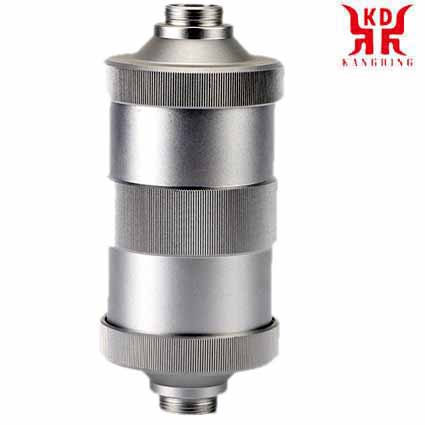황삭하면서도, 범용 공작기계의 스테인리스 철 소재의 반정삭 및 정삭도 어렵지 않습니다.. 하지만, 높은 절삭력 문제를 해결하는 방법, 높은 온도, 심각한 공구 마모 및 낮은 내구성, 고생산성 특수자동선반 스테인리스강 절단시 표면품질 불량 및 생산성 저하. 한 번의 선삭 작업으로 도면 요구 사항을 충족하기가 어렵습니다.. 당사 공장에서 마르텐사이트계 스테인리스강 소재를 CNC 가공하는 과정에서: 공구 재료 선택부터, 공구 형상 및 구조 선택; 절단량 선택; 블랭크 재료의 피드 상태; 윤활유 및 냉각수 선택에 대해 반복적인 테스트가 수행되었습니다., 그리고 특정 성공적인 경험을 얻었습니다.. 3Cr13 스테인리스 철을 예로 들어 보겠습니다..

스테인레스 철 부품 터닝
Difficulties and Cause Analysis in Cutting Process
During the trial production of parts, our factory conducted a turning test on 3Crl3 steel according to the process of turning ordinary carbon steel. The result is severe tool wear, low productivity, and substandard surface quality of parts.
Comparing the mechanical properties of 3Crl3 steel with 40 강철, 45 steel and other carbon structural steels, 3Crl3 steel has higher strength, elongation, section shrinkage, impact performance and other indicators than 40 steel and 45 강철. It is a medium carbon martensitic stainless steel with high strength and good plasticity. Due to severe work hardening, high cutting resistance and high cutting temperature during cutting, serious tool wear is caused, which increases the number of tool sharpening, increases downtime and machine tool adjustment time, and reduces productivity. And because it is easy to stick to the knife, a built-up edge is generated, which causes the change of the workpiece size and affects the surface roughness. 게다가, the chips are not easy to curl and break, and damage the machined surface of the workpiece, which directly affects the quality of the parts. 그러므로, the process of cutting 45 steel cannot be used to cut 3Crl3. It is also impossible to copy the processing method of a general-purpose lathe to an automatic lathe. Because the automatic lathe has less tools, it is required that the machined surface can reach the required size and surface roughness in one pass to ensure high productivity.
In response to the above problems, our factory has taken the following measures.
3. Main technical measures taken
1) Use heat treatment to change the hardness of the material
The different hardness of martensitic stainless steel after heat treatment has a great influence on turning. Table 1 shows the turning situation of 3Cr13 steel with different hardness after heat treatment with a turning tool of YW2 material. It can be seen that although the hardness of martensitic stainless steel in the annealed state is low, its turning performance is poor. This is because the material has large plasticity and toughness, uneven structure, strong adhesion and fusion, and is prone to knife bumps during cutting, and it is difficult to obtain better surface quality. The 3Cr13 material with hardness below HRC30 after quenching and tempering treatment has better processability and is easy to achieve better surface quality. The parts processed when the hardness is greater than HRC30, although the surface quality is good, but the tool is easy to wear. 그러므로, after the material enters the factory, it is first quenched and tempered, and the hardness reaches HRC25 to 30, and then the cutting process is carried out.
2) Selection of turning tool materials
Under the condition of the same cutting parameters, our factory has carried out a comparison test of turning tools of several materials. Cylindrical turning tools using TiC-TiCN-TiN composite coating inserts have high durability, good workpiece surface quality and high productivity. This is because the blade of this coated cemented carbide material has better strength and toughness, and because of its surface has higher hardness and wear resistance, smaller friction coefficient and higher heat resistance. It has become a good tool material for turning stainless steel by automatic lathes, and is the first choice for external turning tools for processing 3Cr13 stainless steel in our factory. Since there is no cutting blade of this material, it can be seen from the comparison test in Table 2 that the cutting performance of YW2 carbide is also good, so the blade of YW2 material can be selected as the cutting tool.
3) Selection of the geometric angle and structure of the tool
For good tool materials, it is particularly important to choose a reasonable geometric angle.
The rake angle g0 directly affects the strength and thermal conductivity of the tool. 일반적으로, when turning martensitic stainless steel, it is more appropriate to take the rake angle of the tool from 10° to 20°. The rear angle a0 is appropriate to take 5° to 8°, and the maximum should not exceed 10°.
The blade inclination angle ls, the negative blade inclination angle can protect the tip of the blade and improve the strength of the blade. 일반적으로, g0 is selected as -10°~30°.
The main declination angle Kr should be selected according to the shape of the workpiece, the processing position and the tool loading situation.
The surface roughness of the cutting edge should be Ra0.4-0.2μm.
In the tool structure, our factory adopts the outer inclined arc chip breaker for the outer circle turning tool. The chip curling radius is large near the tool tip, and the chip curling radius is small near the outer edge. The chips turn to the surface to be machined and break, and the chip breaking is good. For the cutting knife, our factory controls the secondary declination angle within 1°, which can improve the chip removal condition and prolong the service life of the tool.
 English
English العربية
العربية 中文(漢字)
中文(漢字) Čeština
Čeština Dansk
Dansk Nederlands
Nederlands Suomi
Suomi Français
Français Deutsch
Deutsch Italiano
Italiano 日本語
日本語 ಕನ್ನಡ
ಕನ್ನಡ 한국어
한국어 Português
Português Русский
Русский Slovenčina
Slovenčina Español
Español Svenska
Svenska Türkçe
Türkçe

